
197 posts
(Asio Flammeus) : 34 42 , - 0,23-0,39 , - 0,24-0,43 . , , "" .


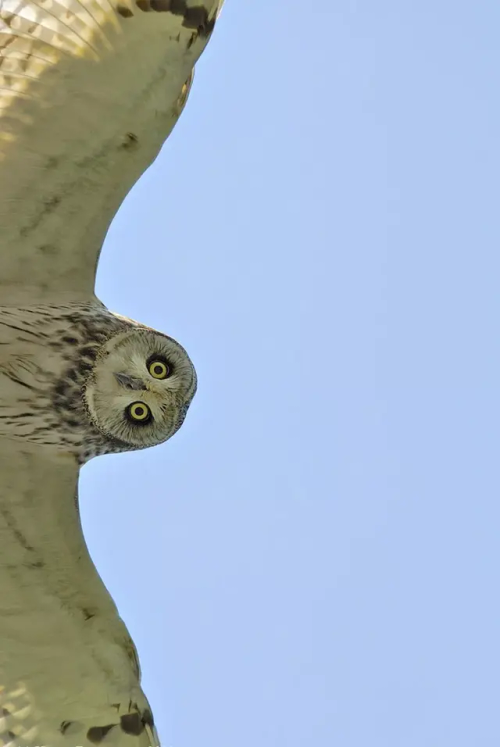
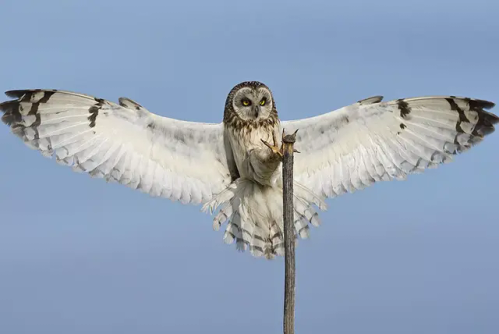


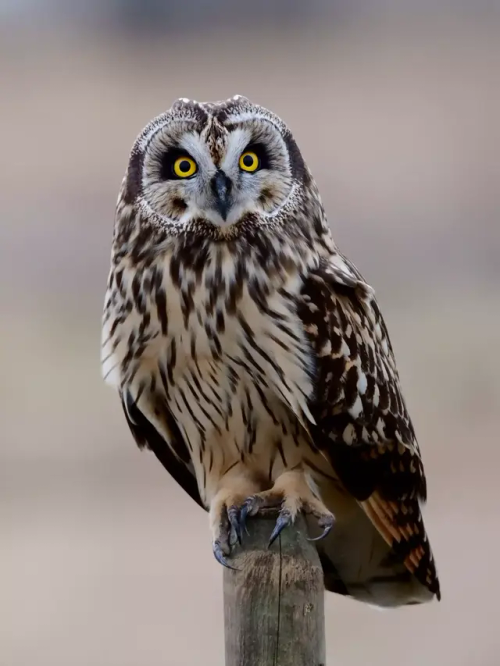



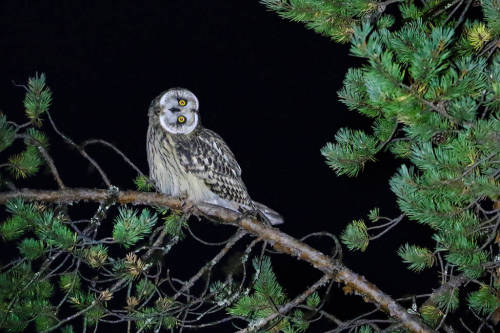











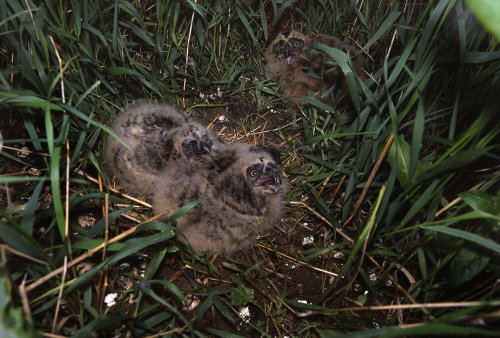


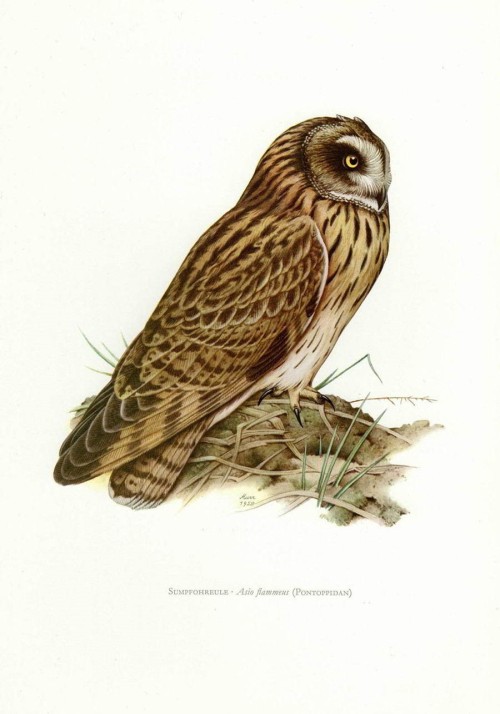
Болотная сова (Asio flammeus) – среднего размера сова: длина ее тела колеблется от 34 до 42 см, вес самцов - 0,23-0,39 кг, самок - 0,24-0,43 кг. Крылья у нее длинные, ноги украшены пучками из перьев, на голове расположены маленькие вертикально стоящие "ушки" из перьев.
Болотная сова распространена очень широко, она обитает на всех континентах, кроме Австралии и Антарктики и населяет соленоводные болота, прибрежные равнины, хвойные леса, тундру, трясины, поля, прерии, высокотравные степи (часто с солончаками), луга (в поймах рек и озер), гористые местности и субальпийские луга, сельскохозяйственные угодья и парковые насаждения. Во всех местах обитания болотная сова придерживается открытых пространств.
Большую часть рациона этой птицы составляют мелкие грызуны (мыши, полёвки, лемминги, крысы, хомяки и ондатры), кролики, землеройки, летучие мыши, птицы (кулики, крачки, мелкие чайки, жаворонки и дрозды), насекомые (кузнечики, жуки, гусеницы) и иногда рыба.
Охотится болотная сова в любое время суток, низко паря над открытым пространством. На добычу она обычно нападает с полета или из засады и несёт ее в когтях. Болотные совы – моногамы и образуют постоянные пары. Самец привлекает самку на свой участок красивыми пируэтами в воздухе. Иногда в брачных полетах участвуют обе птицы: они гоняются друг за другом, сцепляются когтями или в шутку борются. Гнездом обычно служит расчищенная самкой ямка диаметром до 40 см на вершине плоской кочки среди густой травы или тростника. В кладке 4–7 яиц, которые насиживает самка.
Swamp Owl (Asio flammeus) – medium-sized owl: its body length ranges from 34 to 42 cm, the weight of males is 0.23-0.39 kg, females - 0.24-0.43 kg. Her wings are long, her legs are decorated with tufts of feathers, and small vertically standing "ears" of feathers are located on her head.
The is very widespread, it lives on all continents except Australia and Antarctica and inhabits saltwater swamps, coastal plains, coniferous forests, tundra, bogs, fields, prairies, tall grass steppes (often with salt marshes), meadows (in floodplains of rivers and lakes), mountainous areas and subalpine meadows, agricultural lands and parkland. In all habitats, the swamp owl adheres to open spaces.
Most of the diet of this bird consists of small rodents (mice, voles, lemmings, rats, hamsters and muskrats), rabbits, shrews, bats, birds (sandpipers, terns, small gulls, larks and thrushes), insects (grasshoppers, beetles, caterpillars) and sometimes fish.
The swamp owl hunts at any time of the day, hovering low over an open space. It usually attacks prey from flight or from ambush and carries it in its claws. Swamp owls are monogamous and form permanent pairs. The male attracts the female to his site with beautiful pirouettes in the air. Sometimes both birds participate in mating flights: they chase each other, lock claws or jokingly fight. The nest is usually a hole cleared by a female with a diameter of up to 40 cm on top of a flat hummock among dense grass or reeds. There are 4-7 eggs in the clutch, which are incubated by the female.
Источник://www.ebirds.ru/vid/225.htm,/bigenc.ru/c/bolotnaia-sova-bb9577,/zoogalaktika.ru/photos/aves/strigiformes/asio-flammeus, //www.mos.ru/news/item/86280073/,://ecology.polotsk.museum.by/node/42982,/russia.birding.day/v2taxon.php?s=423&l=ru.
-
 minawii-sports liked this · 9 months ago
minawii-sports liked this · 9 months ago -
 minawii-sports reblogged this · 9 months ago
minawii-sports reblogged this · 9 months ago -
 sanoups liked this · 9 months ago
sanoups liked this · 9 months ago -
 dream-world-universe liked this · 10 months ago
dream-world-universe liked this · 10 months ago -
 northameicanblog liked this · 10 months ago
northameicanblog liked this · 10 months ago -
 iamblessedtruly liked this · 10 months ago
iamblessedtruly liked this · 10 months ago -
 ferret-milk liked this · 10 months ago
ferret-milk liked this · 10 months ago -
 scooby-doo-exploration liked this · 10 months ago
scooby-doo-exploration liked this · 10 months ago -
 ludmila199 liked this · 10 months ago
ludmila199 liked this · 10 months ago -
 new-lonewilson reblogged this · 10 months ago
new-lonewilson reblogged this · 10 months ago -
 new-lonewilson liked this · 10 months ago
new-lonewilson liked this · 10 months ago -
 fractal888 liked this · 10 months ago
fractal888 liked this · 10 months ago -
 j0njack liked this · 10 months ago
j0njack liked this · 10 months ago -
 faunidae liked this · 11 months ago
faunidae liked this · 11 months ago -
 gentilhommejfgh liked this · 11 months ago
gentilhommejfgh liked this · 11 months ago -
 mdoubledos liked this · 11 months ago
mdoubledos liked this · 11 months ago -
 jenna92 liked this · 11 months ago
jenna92 liked this · 11 months ago -
 110car8s liked this · 11 months ago
110car8s liked this · 11 months ago -
 christabelq liked this · 11 months ago
christabelq liked this · 11 months ago -
 phantomofthering liked this · 11 months ago
phantomofthering liked this · 11 months ago -
 imortellekim liked this · 11 months ago
imortellekim liked this · 11 months ago -
 mimimoye liked this · 11 months ago
mimimoye liked this · 11 months ago -
 huzur-un liked this · 11 months ago
huzur-un liked this · 11 months ago -
 vuonkhuya liked this · 11 months ago
vuonkhuya liked this · 11 months ago -
 semide liked this · 11 months ago
semide liked this · 11 months ago -
 williamskyw liked this · 11 months ago
williamskyw liked this · 11 months ago -
 kojj liked this · 11 months ago
kojj liked this · 11 months ago -
 wernher-von-brawny reblogged this · 11 months ago
wernher-von-brawny reblogged this · 11 months ago -
 thethirdman8 liked this · 11 months ago
thethirdman8 liked this · 11 months ago -
 bardofthebored liked this · 11 months ago
bardofthebored liked this · 11 months ago -
 we-thebigchris-things reblogged this · 11 months ago
we-thebigchris-things reblogged this · 11 months ago -
 we-thebigchris-things liked this · 11 months ago
we-thebigchris-things liked this · 11 months ago -
 sergioguymanproust liked this · 11 months ago
sergioguymanproust liked this · 11 months ago -
 naser1963 liked this · 11 months ago
naser1963 liked this · 11 months ago -
 el-zorro-chile liked this · 11 months ago
el-zorro-chile liked this · 11 months ago -
 ninomeira liked this · 11 months ago
ninomeira liked this · 11 months ago -
 deafeningsoulpeachrebel liked this · 11 months ago
deafeningsoulpeachrebel liked this · 11 months ago -
 abuayasworld reblogged this · 11 months ago
abuayasworld reblogged this · 11 months ago -
 abuayasworld liked this · 11 months ago
abuayasworld liked this · 11 months ago -
 darkelpie liked this · 11 months ago
darkelpie liked this · 11 months ago -
 1-125sec-f8-10feet liked this · 11 months ago
1-125sec-f8-10feet liked this · 11 months ago -
 hvynh-wxrld liked this · 11 months ago
hvynh-wxrld liked this · 11 months ago -
 angel-oriel liked this · 11 months ago
angel-oriel liked this · 11 months ago -
 gaiawatcher liked this · 11 months ago
gaiawatcher liked this · 11 months ago -
 yourglockglockglock-blog liked this · 11 months ago
yourglockglockglock-blog liked this · 11 months ago -
 00wls00wls00wls reblogged this · 11 months ago
00wls00wls00wls reblogged this · 11 months ago -
 brunothegrape liked this · 11 months ago
brunothegrape liked this · 11 months ago
More Posts from Vestaignis

























Каскад живописных Бадукских озер самый знаменитый туристический объект, лежит в долине р. Бадук между между грозными стенами хребтов Бадук и Хаджибей. Они расположены в охранной зоне Тебердинского заповедника, на территории Карачаево-Черкессии, в непосредственной близости от Домбая. В геологическом плане они являются молодыми (около 200 лет). Эти водоёмы - результат природных преобразований, связанных с образованием на реке крупных запруд. Эти запруды, в свою очередь, возникли из-за обвалов камней. Бадукские озера наполнены абсолютно прозрачной водой, цвет которой меняется в зависимости от погоды и времени суток. Иногда она кажется нежно-бирюзовой, а иногда – темно-фиолетовой. В озерах обитает форель, но поскольку они находятся в заповеднике, рыбалка здесь запрещена. По берегам растут сосны и березовое криволесье, но зимой лавины часто уничтожают и кустарники, и деревья.В границах заповедника, кроме водоемов, расположены ледники, скальные гряды, заливные луга и массивы лесов. Всего водоемов три:
-Первый – самый крошечный. Его диаметр всего 80 метров, а глубина не доходит и до 5 м. Вода в нем очень студеная – круглый год она не превышает отметку +5С.
-Второй водоем, находящийся на 260 м выше – несколько крупнее. Его диаметр достигает 200 метров. Бадукские озера (высота второго из них – 1987 м относительно уровня моря) располагаются одно за другим, постепенно поднимаясь в гору.
-Третье – самое огромное. Его размеры составляют 330 на 200 метров, а площадь превышает 3,5 гектара. Здесь восторженно замирают все, приехавшие на Бадукские озера – фото этих мест потрясают и завораживают. Глубина его достигает 9 метров, а вода прозрачная и чистая. В пользу последнего факта говорит то, что в Большом Бадукском издавна поселилась форель. Водоем плещется выше своих собратьев, на высоте 1 990 метров. В этом озере нередко купаются туристы – хотя оно довольно прохладное, но невероятно чистое. Здесь в конце весны и в начале лета цветет белый рододендрон.
По словам большинства туристов, в эти места хорошо приезжать золотой осенью, с середины сентября и до конца октября. В это время сочная зелень окрашивается в яркие цвета, что отражается в лазурной глади озерных вод – потрясающее зрелище. Эффектные фотографии получаются на берегах озер. Интересно запечатлеть течение Теберды с подвесного моста возле трассы и место слияния стремительных рек Бадук и Хаджибей.
The cascade of picturesque Baduk lakes, the most famous tourist attraction, lies in the valley of the river. Baduk between the formidable walls of the Baduk and Khadzhibey ridges. They are located in the protected zone of the Teberda Nature Reserve, on the territory of Karachay-Cherkessia, in close proximity to Dombay.
Geologically, they are young (about 200 years old). These reservoirs are the result of natural transformations associated with the formation of large dams on the river. These dams, in turn, arose due to rock falls. The Baduk lakes are filled with absolutely clear water, the color of which changes depending on the weather and time of day. Sometimes it appears soft turquoise, and sometimes dark purple. The lakes are home to trout, but since they are located in a nature reserve, fishing is prohibited here. Pine trees and crooked birch forests grow along the banks, but in winter avalanches often destroy both shrubs and trees. Within the boundaries of the reserve, in addition to reservoirs, there are glaciers, rocky ridges, water meadows and forests. There are three reservoirs in total:
-The first one is the tiniest. Its diameter is only 80 meters, and its depth does not even reach 5 m. The water in it is very cold - all year round it does not exceed +5C.
-The second reservoir, located 260 m higher, is somewhat larger. Its diameter reaches 200 meters. The Baduk lakes (the height of the second of them is 1987 m relative to sea level) are located one after another, gradually rising up the mountain.
- The third is the largest. Its dimensions are 330 by 200 meters and its area exceeds 3.5 hectares. Here everyone who comes to the Baduk Lakes freezes with delight - the photos of these places are stunning and mesmerizing. Its depth reaches 9 meters, and the water is clear and clean. The latter fact is supported by the fact that trout have long settled in Bolshoy Baduksky. The reservoir splashes higher than its fellows, at an altitude of 1,990 meters. Tourists often swim in this lake - although it is quite cool, it is incredibly clean.White rhododendron blooms here in late spring and early summer.
According to most tourists, it is good to come to these places in the golden autumn, from mid-September to the end of October. At this time, the lush greenery turns into bright colors, which is reflected in the azure surface of the lake waters - a stunning sight. Spectacular photographs are taken on the shores of lakes.It is interesting to capture the flow of the Teberda from the suspension bridge near the highway and the confluence of the fast-moving rivers Baduk and Khadzhibey.
Источник://t.me/divo_planeta,/pikabu.ru/story/dombay_badukskie_ozera_7787251,//treepics.ru/16876-badukskie-ozera-zimoi,//dombay. krymea.ru /badukskie-ozera/,/turisticum.ru/baduki/,//kukarta.ru / badukskie-ozera,/bolshayastrana.com /dostoprimechatelnosti / dombaj/badukskie-ozyora-60,/kukarta.ru/badukskie-ozera/, club-voshod.com/info/pohodnoe_info/dostoprimechatelnosti/dombay/dombay_badukskie_ozera/,/bolshayastrana.com/dostoprimechatelnosti/dombaj/badukskie-ozyora-60,/www.kp.ru/russia /dombaj/mesta /badukskie-ozera/.
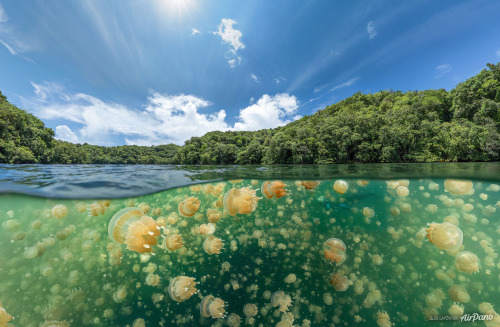
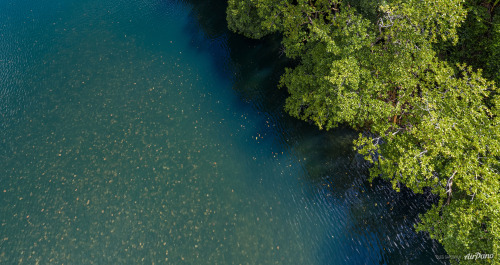



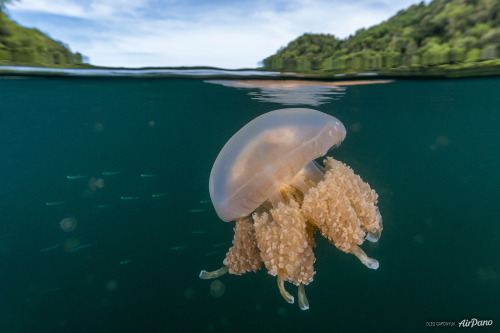

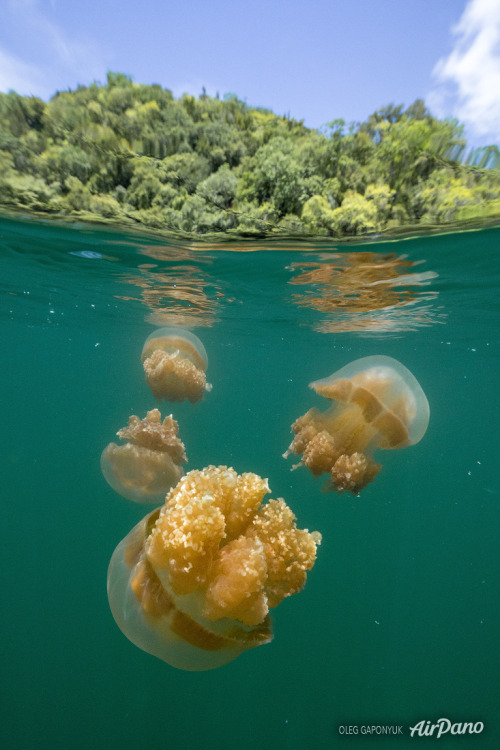
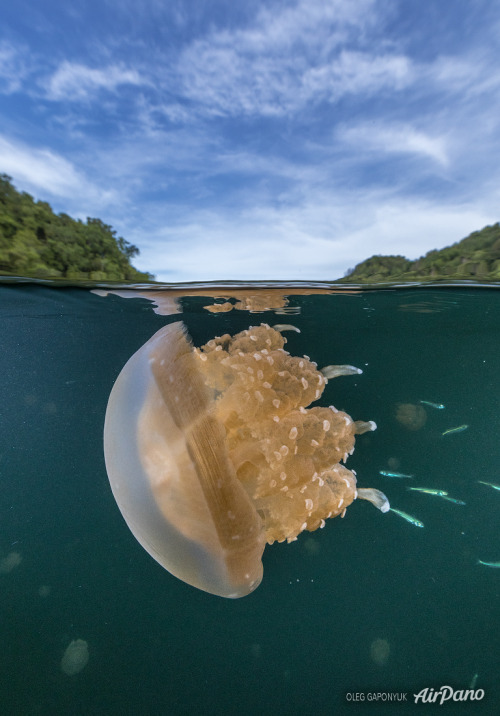

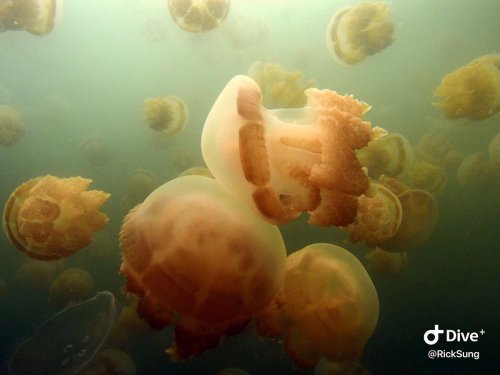
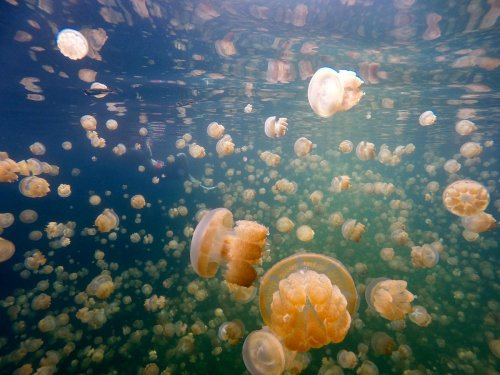

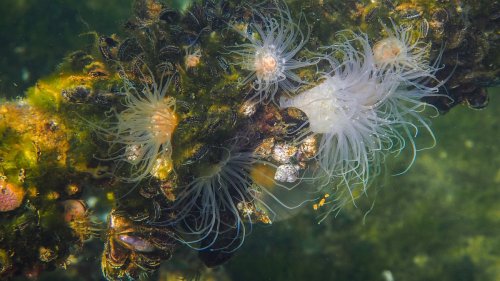

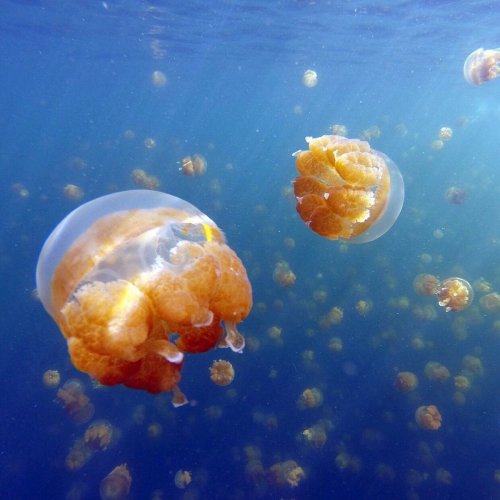
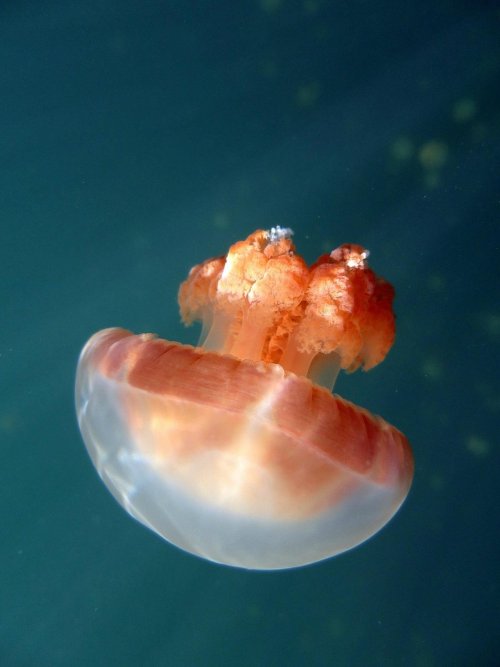


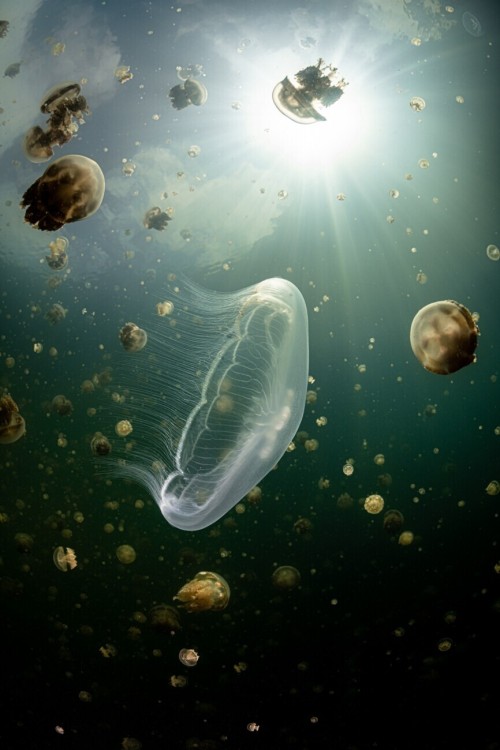
Озеро Медуз — озеро в архипелаге Скалистые острова (Палау). Озеро расположено на востоке острова Эйл-Малк, в более чем 20 км к юго-востоку от Корора. Этот естественный слабо-солёный водоем имеет глубину до 50 метров и размеры всего 460 м на 160 м, он сообщается с расположенным примерно в 200 метрах Тихим океаном через трещины и поры в горной породе.
Озеро Медуз разделено на два слоя — бескислородный и с большим содержанием кислорода. Первый, нижний слой (приблизительно от глубины 15 метров и до дна) обладает высокой концентрацией аммиака и фосфатов, чем опасен для дайверов, которые могут получить отравление через кожу. В этом слое живут только бактерии. Зато другой слой, насыщенный кислородом (примерно до глубины 15 м), населяют разнообразные микроорганизмы, несколько видов рыб и веслоногих ракообразных и, конечно же, медузы.
Образованное движением земной коры более 12 000 лет назад озеро известно своей обособленной популяцией двух видов сцифоидных — золотая медуза (Mastigias papua) и лунная медуза (Aurelia). За время, проведенное вдали от моря, живущие здесь золотисто-оранжевые медузы эволюционировали и утратили свою способность жалить. Весь день они следуют за солнцем, перемещаясь по глади озера, а к ночи опускаются на дно, где подпитываются водорослями. Лунные медузы питаются веслоногими ракообразными, для чего ночью поднимаются на поверхность озера. Считается,что общая численность медуз, обитающих в этом необычном озере, достигает двух миллионов особей. Количество медуз так велико, что их массу легко можно заметить, даже находясь в самолете. Золотая медуза имеет огромное численное превосходство над лунной.
Кроме того, в озере Медуз не разрешено нырять с аквалангом. Воздушные пузырьки, которые образуются во время дыхания аквалангиста, попадают под купол медузы и могут привести к ее гибели. По этим причинам в озере плавают только в верхнем слое воды, используя ласты и маску. Погружение в воды этого медузового озера – удивительная возможность попасть в иной мир, оказавшись в самом центре гипнотического танца медуз.
Jellyfish Lake is a lake in the Rocky Islands archipelago (Palau). The lake is located on the east of Eil Malk Island, more than 20 km southeast of Koror. This natural, slightly saline body of water is up to 50 meters deep and measures just 460 m by 160 m, connecting to the Pacific Ocean about 200 meters away through cracks and pores in the rock.
Jellyfish Lake is divided into two layers: anoxic and highly oxygenated. The first, lower layer (from approximately a depth of 15 meters to the bottom) has a high concentration of ammonia and phosphates, which is dangerous for divers, who can become poisoned through the skin. Only bacteria live in this layer. But another layer, saturated with oxygen (to about a depth of 15 m), is inhabited by a variety of microorganisms, several species of fish and copepods and, of course, jellyfish.
Formed by the movement of the earth's crust over 12,000 years ago, the lake is known for its distinct population of two scyphoid species - the golden jellyfish (Mastigias papua) and the moon jellyfish (Aurelia). During their time away from the sea, the golden-orange jellyfish that live here have evolved and lost their ability to sting. All day they follow the sun, moving along the surface of the lake, and by night they sink to the bottom, where they feed on algae. Moon jellyfish feed on copepods, for which they rise to the surface of the lake at night. It is believed that the total number of jellyfish living in this unusual lake reaches two million individuals. The number of jellyfish is so large that their mass can be easily noticed even while on an airplane. The golden jellyfish has a huge numerical superiority over the lunar jellyfish.
Additionally, scuba diving is not allowed in Jellyfish Lake. Air bubbles that form during the scuba diver's breathing fall under the dome of the jellyfish and can lead to its death.For these reasons, people swim in the lake only in the upper layer of water, using fins and a mask. Diving into the waters of this jellyfish lake is an amazing opportunity to enter another world, finding yourself in the very center of the hypnotic dance of jellyfish.
Источник: //www.stepandstep.ru/biologiya/ozero-meduz, //cameralabs.org/aeon/fotokonkurs-siena-international-awards /foto/ 46069-pooshchritelnaya-premiya-v-kategorii-krasota-prirody-2021-ozero-meduz-avtor-khenli-spajers,//www.cawater-info.net /all_about _water/?p=14456,dzen.ru/a/XbytncBccQCufY29, //topwonders .ru / palau/ozero-meduz-na-palau.html,omyworld.ru/9937,//www. stepandstep.ru/biologiya/ozero-meduz/,/www.airpano.ru /360article / jellyfish-lake-palau/,/www.tripadvisor.ru/Attraction_Review-g294136-d795830-Reviews-Jellyfish_Lake-Koror_Koror_Island.html.


















Медуза Яичница (Котилориза) Cotylorhiza tuberculata.
У медузы котилоризы есть веселое название «жареное яйцо» или «медуза яичница». Эта медуза в первую очередь примечательна своей внешностью — ее купол имеет выпуклость, чем-то напоминающую желток яичницы. Она может достигать приличных размеров, до 35-40 см в диаметре,а периметр их диска разделен на 16 равных долей, которые в свою очередь разделены еще на более чем сотню более мелких долей. В условиях домашнего содержания эта медуза вырастает до 5-8 см в диаметре купола.
«Медуза яичница» является одним из самых распространенных видов средиземноморских медуз. Ее также можно встретить в Адриатическом и Эгейском морях, а так же в Атлантическом и Тихом океане, на небольших глубинах теплой океанской воды до 165 футов (50,2 м).
Медузы Котилоризы могут передвигаться автономно, используя силу подводных течений. У Котилоризы есть стрекательные клетки, в которых содержится токсическое вещество, а также очень небольшое жало, к счастью, для людей такие медузы безопасны. Надумаете погладить медузу-яичницу, гладьте сверху — где нет стрекательных клеток. Обратите внимание, у ряда дайверов после контакта с этим животным наблюдают сенсибилизацию — приобретение организмом повышенной чувствительности к чужеродным веществам. Например, аллергия на морепродукты. Иногда мелкие рыбки находят защиту от хищников в щупальцах этой медузы.
Jellyfish cotylorhiza has the fun name of "fried egg" or "fried egg jellyfish." This jellyfish is primarily notable for its appearance - its dome has a bulge that is somewhat reminiscent of the yolk of a fried egg.It can reach decent sizes, up to 35-40 cm in diameter, and the perimeter of their disk is divided into 16 equal lobes, which in turn are divided into more than a hundred smaller lobes. When kept at home, this jellyfish grows to 5-8 cm in dome diameter.
The "fried egg jellyfish" is one of the most common types of Mediterranean jellyfish. It can also be found in the Adriatic and Aegean seas, as well as in the Atlantic and Pacific oceans, in shallow depths of warm ocean water up to 165 feet (50.2 m).
Cotylorhiza jellyfish can move autonomously using the power of underwater currents. Cotylorhiza has stinging cells that contain a toxic substance, as well as a very small sting; fortunately, such jellyfish are safe for humans. If you decide to stroke a fried egg jellyfish, stroke it from above - where there are no stinging cells. Please note that a number of divers, after contact with this animal, experience sensitization - the body acquires increased sensitivity to foreign substances. For example, an allergy to seafood. Sometimes small fish find protection from predators in the tentacles of this jellyfish.
Источник://www.youtube.com/watch?v=2_w8Ffw3aXM&ab _channel =Psyche%26Wilczykurcgalopkiemprzez%C5%9Bwiat,/pikabu.ru/story/kotiloriza_cotylorhiza_tuberculata_v_mire_morskikh_chudes_11036095,/gagaru.club/29547-kotiloriza-meduza.html,



















Замок «Соколиное гнездо».
Чешская Швейцария – это часть Эльбского Песчаникового горного массива, расположенная на территории Чехии. Здесь настолько невероятно красиво, что государство объявило в 2000 году это место национальным парком Чехии. Парк имеет много интересных мест, но самая интересная достопримечательность - это Правческая Брана или Правчицкие Ворота (Pravčická brána), которые представляют собой самые большие естественные ворота в Европе, образованные из скалистого массива - пролет арки 26,5 м, высота - 16 м.
В 1881 году австрийский принц Эдмунд Клари-Альдринген решил создать на территории своего имения в непосредственной близости от Правчицких ворот одну из самых первых туристических достопримечательностей Европы. Он нанял итальянских мастеров для строительства внушительного замка под названием «Соколиное гнездо». В нынешнее время в замке на втором этаже расположился музей Национального парка Чешская Швейцария, кстати, единственный. На первом этаже есть ресторан с сохранившейся до сих пор оригинальной отделкой деревянных стен и такими же оригинальными потолочными росписями. Интерьер заведения выдержанн в стиле 100-летней давности. С замковой площадки открываются чудесные виды на национальный парк.
The Falcon's Nest Castle.
Czech Switzerland is a part of the Elbe Sandstone Mountain range, located on the territory of the Czech Republic. It is so incredibly beautiful here that the state declared this place a national park of the Czech Republic in 2000. The park has many interesting places, but the most interesting attraction is The right Brane or Pravchicka Gate (Pravčická brána), which is the largest natural gate in Europe, formed from a rocky massif - arch span of 26.5 m, height - 16 m.
In 1881, Austrian Prince Edmund Clary-Aldringen decided to create one of the first tourist attractions in Europe on the territory of his estate in the immediate vicinity of the Pravchitsky Gate. He hired Italian craftsmen to build an impressive castle called the Falcon's Nest. At the present time, the museum of the Czech Switzerland National Park is located in the castle on the second floor, by the way, the only one. On the ground floor there is a restaurant with original wooden wall decoration and the same original ceiling paintings. The interior of the restaurant is designed in the style of 100 years ago. The castle grounds offer wonderful views of the national park.
Источник:/m-just-m.livejournal.com/246797.html, /www. tripadvisor . ru/LocationPhotoDirectLink-g274694-d4722298-i130392589-Czech_Saxon_Switzerland-Hrensko_Usti_ nad_Labem_ Region_ Bohemia.html,/pragagid.ru/letnij-zamok-sokolinoe-gnezdo-cheshskaya-shvejcariya-6157,/tired-tourist.livejournal.com/22927.html, /pbrana.cz/ru/,/gidpraga.eu/product/ceske-svycarsko-from-prague/.



























Озеро Сукко (Кипарисовое озеро), или Голубое озеро — одна из самых популярных и фотогеничных локаций в окрестностях Анапы. Удивительные деревья с узловатыми корнями и приятным смолистым ароматом растут здесь прямо из воды. О происхождении названия озера существует множество предположений. С адыгейского топоним можно перевести как «водоем кабанов». Существует также вариант трактовки «Сукко» как «су» — вода и «къко» – свинья или дельфин. Озеро в Сукко было создано искусственно путем строительства плотины на реке, впадающей в Черное море, что привело к затоплению долины. Этот водоем занимает площадь всего 8 гектаров. Высота Кипарисового озера - 40 м над уровнем моря. Особую известность озеру принес уникальный эксперимент, проведенный в 1934–1935 годах, когда были посажены 32 болотных кипарисов, которые успешно прижились и выросли. Изначально кипарисы были посажены на сухой земле, однако из-за значительных изменений рельефа территории они со временем оказались в воде. В периоды засухи уровень воды в озере понижается, обнажая обширную корневую систему деревьев. Кипарисы достигают внушительной высоты почти в 30 метров, а их стволы могут быть шириной до полуметра. Роща прекрасна практически в любой сезон: весной свежая листва хвойных деревьев нежно-зелёная, летом приобретает более тёмный и насыщенный оттенок, а осенью полыхает ярко-оранжевым или красным цветом. К зиме деревья полностью сбрасывают листву, обнажая ветвистые кроны — в чём тоже есть своя красота.
Из-за обилия известняковых отложений в зависимости от освещения озеро Сукко может менять цвет от нежного молочно-голубого до насыщенного бирюзового. Голубое озеро не только известно своими кипарисами и кристально чистой водой, но и окружающей его природой. Водоем находится среди лесопарка с дубами и грабами, а с северной стороны его окружают склоны горы Широкая. Рядом также расположена можжевеловая роща, создающая лечебный воздух в этой местности.
Lake Sukko (Cypress Lake), or Blue Lake, is one of the most popular and photogenic locations in the vicinity of Anapa. Amazing trees with knotty roots and a pleasant resinous aroma grow here directly from the water. There are many speculations about the origin of the name of the lake. From the Adyghe toponym can be translated as “pond of wild boars.” There is also an option to interpret “Sukko” as “su” - water and “kko” - pig or dolphin. The lake in Sukko was created artificially by building a dam on a river flowing into the Black Sea, which led to flooding of the valley. This reservoir covers an area of only 8 hectares. The height of Cypress Lake is 40 m above sea level. The lake became especially famous due to a unique experiment conducted in 1934–1935, when 32 swamp cypress trees were planted, which successfully took root and grew.Initially, the cypress trees were planted on dry land, but due to significant changes in the terrain, they eventually ended up in water. During periods of drought, the lake's water level drops, exposing the trees' extensive root systems. Cypress trees reach an impressive height of almost 30 meters, and their trunks can be up to half a meter wide. The grove is beautiful in almost any season: in the spring, the fresh foliage of coniferous trees is soft green, in the summer it acquires a darker and richer shade, and in the fall it blazes with bright orange or red. By winter, the trees completely shed their leaves, revealing branched crowns - which also has its own beauty.
Due to the abundance of limestone deposits, depending on the lighting, Lake Sukko can change color from delicate milky blue to rich turquoise. Blue Lake is not only famous for its cypress trees and crystal clear water, but also for the nature that surrounds it. The reservoir is located among a forest park with oaks and hornbeams, and on the northern side it is surrounded by the slopes of Mount Shirokaya. There is also a juniper grove nearby, which creates healing air in this area.
Источник: https://kukarta.ru/ozero-sukko,//ezhevika-travel.ru /tur/ozero-sukko-foto,/turistexpert.ru/rossiya/anapa/kiparisovoe-ozero/,//kiparisovoe-ozero.ru,/blijehotel.ru/articles/kiparisovoe-ozero/, /experience.tripster.ru/sights/kiparisovoe-ozero-sukko/, /www.tripadvisor.ru/Attraction_Review-g3226223-d2331079-Reviews-Sukko_Lake-Sukko_Krasnodar_Krai_Southern_District.html.